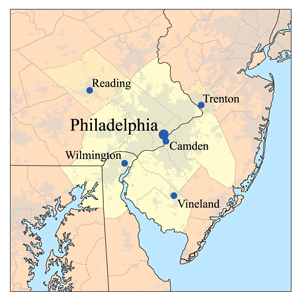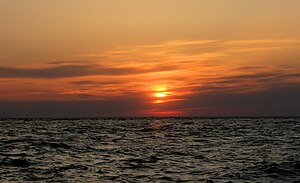
New Jersey is a state situated within both the Mid-Atlantic and Northeastern regions of the United States. It is the most densely populated of all 50 U.S. states, and is situated at the center of the Northeast megalopolis. New Jersey is bordered on its north and east by New York state; on its east, southeast, and south by the Atlantic Ocean; on its west by the Delaware River and Pennsylvania; and on its southwest by Delaware Bay and Delaware. At 7,354 square miles (19,050 km2), New Jersey is the fifth-smallest state in land area, but with close to 9.3 million residents as of the 2020 United States census, its highest decennial count ever, it ranks 11th in population. The state capital is Trenton, and the state's most populous city is Newark. New Jersey is the only U.S. state in which every county is deemed urban by the U.S. Census Bureau with 13 counties included in the New York metropolitan area, seven counties in the Philadelphia metropolitan area, and Warren County part of the heavily industrialized Lehigh Valley metropolitan area.

Gloucester County is a county in the U.S. state of New Jersey. As of the 2020 census, the county was the state's 14th-most populous county with a population of 302,294, its highest decennial count ever and an increase of 14,006 (+4.9%) from the 288,288 counted in the 2010 census, which in turn represented an increase of 33,615 (+13.2%) from the 2000 census population of 254,673. Its county seat is Woodbury. The county is part of the South Jersey region of the state.

Cumberland County is a coastal county located on the Delaware Bay in the Southern Shore Region of the U.S. state of New Jersey. As of the 2020 census, the county was the state's 16th-most-populous county, with a population of 154,152, a decrease of 2,746 (−1.8%) from the 2010 census count of 156,898. Its county seat is Bridgeton. Cumberland County is named for Prince William, Duke of Cumberland. The county was formally created from portions of Salem County on January 19, 1748. The county is part of the South Jersey region of the state.

Camden County is a county located in the U.S. state of New Jersey. Its county seat is Camden. As of the 2020 census, the county was the state's ninth-most populous county, with a population of 523,485, its highest decennial count ever and an increase of 9,828 (+1.9%) from the 2010 census count of 513,657, which in turn reflected an increase of 4,725 (0.9%) from the 508,932 counted in the 2000 census. The county is part of the South Jersey region of the state.

Atlantic County is a county located along the Jersey Shore in the U.S. state of New Jersey. As of the 2020 census, the county was the state's 15th-most-populous county, with a population of 274,534, a drop of 15 from the 2010 census count of 274,549. Its county seat is the Mays Landing section of Hamilton Township. The county is part of the South Jersey region of the state.
Scouting in New Jersey has a long history, from the 1910s to the present day, serving thousands of youth in programs that suit the environment in which they live. The second Boy Scouts of America National Headquarters was in North Brunswick, although it was referred to in BSA publications as being in neighboring New Brunswick.

The Delaware Valley, sometimes referred to as Greater Philadelphia or the Philadelphia metropolitan area, is a metropolitan region in the Northeast United States that centers around Philadelphia, the nation's sixth-most populous city, and spans parts of four U.S. states: southeastern Pennsylvania, southern New Jersey, northern Delaware, and the northern Eastern Shore of Maryland. With a core metropolitan statistical area population of 6.288 million residents and a combined statistical area population of 7.366 million as of the 2020 census, the Delaware Valley is the eighth-largest metropolitan region in the nation and North America, and the 68th-largest metropolitan region in the world.

The New Jersey Pine Barrens, also known as the Pinelands or simply the Pines, is the largest remaining example of the Atlantic coastal pine barrens ecosystem, stretching across more than seven counties of New Jersey. Two other large, contiguous examples of this ecosystem remain in the northeastern United States: the Long Island Central Pine Barrens and the Massachusetts Coastal Pine Barrens. The name pine barrens refers to the area's sandy, acidic, nutrient-poor soil. Although European settlers could not cultivate their familiar crops there, the unique ecology of the Pine Barrens supports a diverse spectrum of plant life, including orchids and carnivorous plants. The area is also notable for its populations of rare pygmy pitch pines and other plant species that depend on the frequent fires of the Pine Barrens to reproduce. The sand that composes much of the area's soil is referred to by the locals as sugar sand.

The Pennsylvania-Reading Seashore Lines was a railroad that operated in South Jersey in the 20th century. It was created in 1933 as a joint consolidation venture between two competing railroads in the region: the Pennsylvania Railroad and the Reading Company.

New Jersey is a state within the United States of America that lies on the north eastern edge of the North American continent. It shares a land border with the state of New York along the north, ratified by both states after the New York – New Jersey Line War, which is its only straight line border.

New Jersey has seven metropolitan statistical areas (MSAs) defined by the federal Office of Management and Budget. The New York City and Philadelphia MSAs are also divided into divisions, of which there are five in New Jersey. Every statistical area and county in New Jersey belongs to the Northeast Megalopolis.
The Delaware River Region refers to an area in western New Jersey (US) along the Delaware River border with Pennsylvania. It encompasses Burlington County, Camden County, Gloucester County, Mercer County, and Salem County. The area is primarily part of Greater Philadelphia with the exception of Mercer County, which is part of the New York City Metropolitan Area. It is one of six officially recognized tourism regions by the New Jersey Department of Tourism, the others being the Greater Atlantic City Region, the Skylands Region, the Southern Shore Region, the Shore Region and the Gateway Region.
The Outer Coastal Plain AVA is an American Viticultural Area located in southeastern New Jersey. The recently expanded 2,250,000 acres (911,000 ha) wine appellation includes all of Cumberland, Cape May, Atlantic, and Ocean counties and portions of Salem, Gloucester, Camden, Burlington, and Monmouth counties. The region is characterized by well-drained sandy or sandy loam soils of low to moderate fertility, and a relatively long growing season. The climate is moderated by the influence of the Atlantic Ocean and Delaware Bay. The region is in hardiness zones 6b, 7a, and 7b. The AVA contains one sub-region, the Cape May Peninsula AVA, which was established in 2018.

The Southern Shore Region is located in the South Jersey region of New Jersey. It is one of six tourism regions established by the New Jersey State Department of Tourism, the others are the Gateway Region, Greater Atlantic City, the Delaware River Region, the Shore Region. and the Skylands Region. The area includes Cape May County and Cumberland County. The coast is along the Atlantic Ocean and Delaware Bay, while the inland areas are part of the New Jersey Pine Barrens.
The Atlantic City Railroad was a Philadelphia and Reading Railway subsidiary that became part of Pennsylvania-Reading Seashore Lines in 1933. At the end of 1925, it operated 161 miles (259 km) of road on 318 miles (512 km) of track; that year it reported 43 million ton-miles of revenue freight and 204 million passenger-miles.
There are three metropolitan planning organizations (MPO) in New Jersey. The organizations are the main decision-making forums for selecting projects for the Statewide Transportation Improvement Program (STIP) in deliberations involving the New Jersey Department of Transportation (NJDOT), the New Jersey Transit Corporation (NJT), county and municipal transportation planners and engineers, other transportation implementing agencies, the public and elected officials at the state, county, and municipal levels.




















